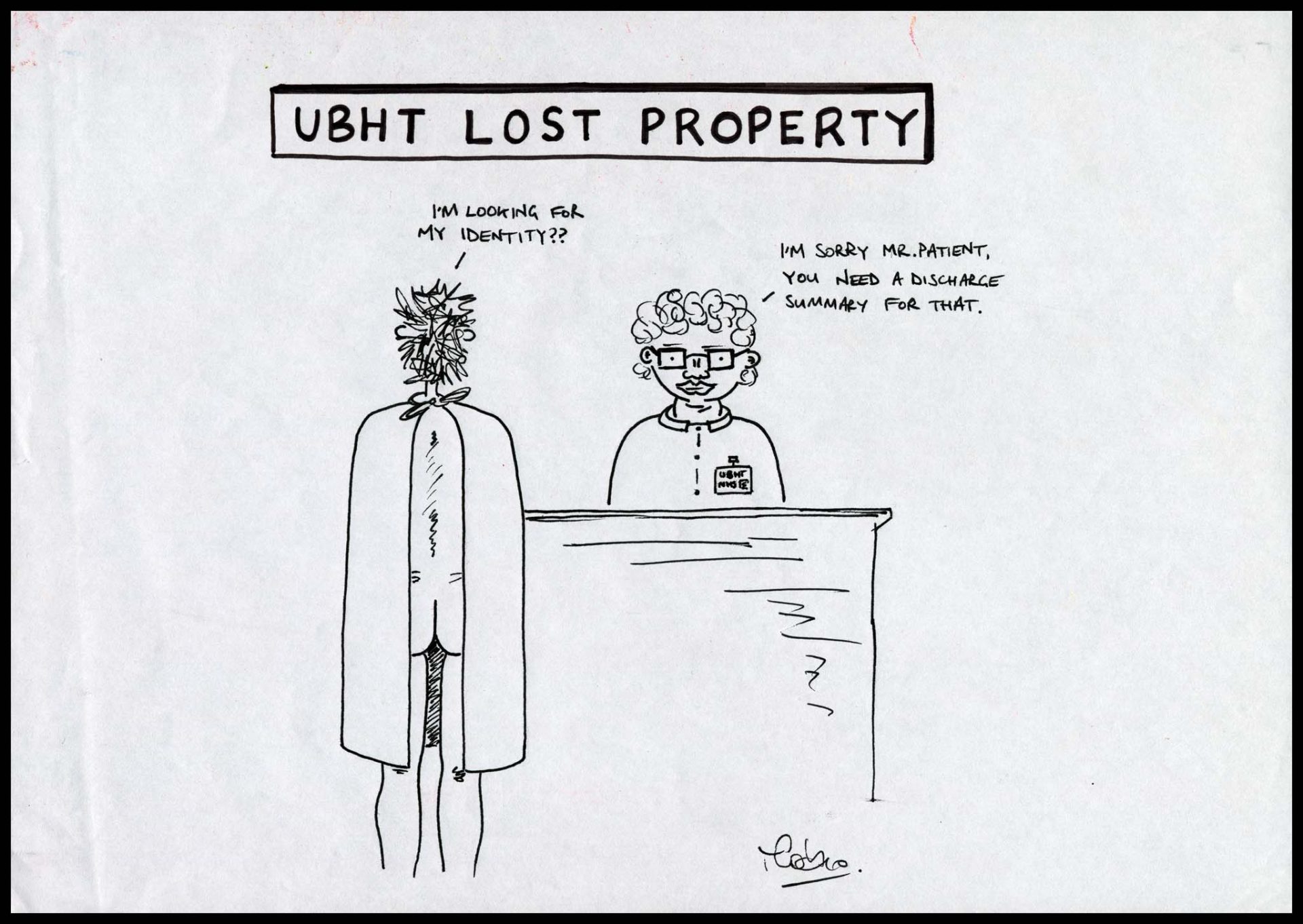U.B.H.T Lost Property
All of a sudden you become a statistic and a disease state: one less free bed. You are stripped of your clothes and hosed down. A mandatory backless gown is tied around your throat and you are taken to your cell/ward and left to introduce yourself to any of the other inmates/patients – who let’s face it, could be total nutters! Those who are seen to be particularly dangerous/contagious are locked in solitary confinement/quarantine for a period of time – length depending on how bad/ill they have been. The officers/consultants are cynical know-it-alls, bur its best not to get on their nerves – they run this place you know! Fortunately you can get your identity back along with any other personal items when you are discharged/get parole. But it is hard on the outside, there can be a lot of stigma-making jobs hard to come by sometimes, your parole officer/G.P. can help you out with any little problems however.

This cartoon clearly highlights the common feeling experienced by people in hospital. The simplicity of the artwork really drives home the point. Healthcare professionals should strive to make patients feel welcome and cared for, it is a dreadful state of affairs that many believe they are thought as ‘the cancer patient’ or ‘Bed 7, Ward B1’ etc… The work suggests we lose our identity when struggling with illness and it is only regained through recovery.
The idea behind the simple cartoon had made me think about the feelings of those inpatients in hospitals. As I cannot ever remember staying in hospital it helped me challenge and review my thoughts of a hospital being a place of recover and help, comparing it to a prison, where people are forced to be, their identity stripped from them. I liked the basic black and white cartoon style chosen by the artist and the construction of the image, with the patient turned away from us, so that the audience could still not see the actual identity of the patient.
Having never been admitted to hospital for any length of time I can only ever imagine how lonely and isolating an experience it is. I believe this cartoon expertly showcases how in a publicly funded healthcare system, constantly trying to maximize efficiency, it is far too easy to overlook the individual and to only see statistics. The fact that we cannot see the subjects face and that he wears a standard issue gown dehumanizes him whilst the use of empty space around the subject seems to further illustrate the emptiness and seclusion that can be felt inside of hospitals. This piece of art has made realize the importance of trying to bring colour and joy into what can be a baron, monochromatic and, solitary world.
I think that working in a hospital, it is so easy to forget that each patient has their own lives and stories happening; it is so easy to allocate that patient with a bed number and forget about them as a person. There is a seemingly endless supply of patients that come in, and in the name of confidentiality, they are given a number. This creates an atmosphere where it is ok to discuss the patient as a bed rather than a human. The piece has been very reflective for me, as healthcare professionals we have to stop ourselves from treating our patients like this, in what is a very isolating environment anyway.
This piece is very effective in conveying the loss of identity experienced by many patients following admission in hospital. There is a greater focus on the illness rather than the patient themselves, who may feel like they have become one of many numbers and forgotten as an individual. The absence of individuality is further highlighted by the member of staff referring to the individual as “Mr Patient” and through the simplicity of the drawing with the patient’s face being withheld from the viewer. The link made between hospital and prison is interesting and a patient may feel their freedom has been restricted. This piece shows me how important it is for healthcare professionals to consider each patient as unique because this will help improve their care of the patient and the patient’s experience.
The comic considers an aspect of patient welfare which is frequently overlooked.
The generally undressed state of the patient shows, alongside the fact that they are faced away means the patient doesn’t really have any identifiable features shown, and is hence “just another patient” to the viewer.
The hospital is not a place where it is easy for patients to engage in their hobbies, meet family or friends and be able to do their day to day activities independently, this can strip away a patient’s identity, as they are not free to do what they truly want to do. Instead they are prescribed a routine, and whilst this may be necessary for their health, it could feel like their body’s aren’t in sync with their mind, and lead to a loss of self.
Patients to hospital staff may be more defined by their condition or bed number, but they are so much more than that. Perhaps an important part of patient welfare is reminding patients and treating them as more than just the state of their health.
It shows how isolating an experiencing in hospital can be and how it has a lasting impact on the individual even after leaving the hospital -all the identity is taken as they can no longer carry out there daily routines I think this is reflected cleverly in the comic as the individual is facing away and also how they are reliant on another individual by asking the desk which represent the reliance on others in hospital